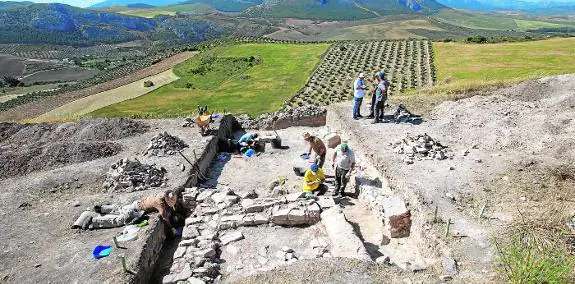The Roman splendour of Los Castillejos
New excavations have brought to light a luxurious, first-century building, highlighting the importance of this Iberian village in the Guadalteba valley
FRANCISCO GRIÑÁN
Miércoles, 5 de febrero 2020, 16:54
At the very start of their operation, the archaeologists had one idea in mind: they were going to find a Roman wall. This was the first time in 26 years that anyone had excavated on this site near Teba and their disappointment was great. However, the team were eventually able to breathe a sigh of relief when they realised they had found an urban section of Los Castillejos, the first-century fortified settlement, or oppidum, of this Ibero-Roman site.
"This is not a little house," explained Pepe Berdugo, a member of the Association for the Defence of the Historical Heritage of Teba-Hins Atiba, who pointed out some large ashlars (finely-cut stones) that gave an idea of the solid Roman construction that was built on the flattest part of the hill.
They have also found paintings, decorated ceramics, remains of fauna and even ivory trinkets.
Experts are more inclined to think this was once a public building, perhaps either a temple or a centre of economic power in the village.
"What is clear is that we have found a great piece of first-century history," said Francisco Melero, director of the excavations which came to an end last week. It is more than a quarter of a century since initial excavations on the site uncovered the 1.2-kilometre Iberian wall that protects the hilltop settlement.
"Since 1993 we have not excavated anything here despite this being the most important oppidum from Iberian times in the province of Malaga," pointed out Bergudo, who together with the members of the Hins Atiba (Teba castle) association, pushed for these excavations. In the end they went ahead with a budget of 20,000 euros financed by Teba town hall.
The settlement of Los Castillejos is thought to have been most important in the fourth and fifth centuries BC. Its decline has been placed in the first century AD.
"We believed that the abandonment occurred in favour of the nearby Roman settlement of Cortijo del Tajo, but that is no longer so clear because this is a very important construction from that final period and it tells the story of great splendour until the very last moment," explained Francisco Melero, who points to some dark areas on the ground suggesting signs of fire and destruction.
"We still don't know whether the site was abandoned due to destruction or a ritual ceremony," said the archaeologist and director of the dig, who stressed that the abundance of terra sigillata ceramics (fine, red ancient Roman pottery) found, also indicates that this building was a luxurious and central space in the village.
The 50-square-metre space dug out by the archaeologists has revealed the portico of a building with large walls. A flour mill has also been located which would have been used once the area was uninhabited and used for farming.
Los Castillejos offers a journey back in time through this site, which is protected as an Asset of Cultural Interest (BIC). Now, more of its secrets, buried for more than twenty centuries, are being uncovered.
